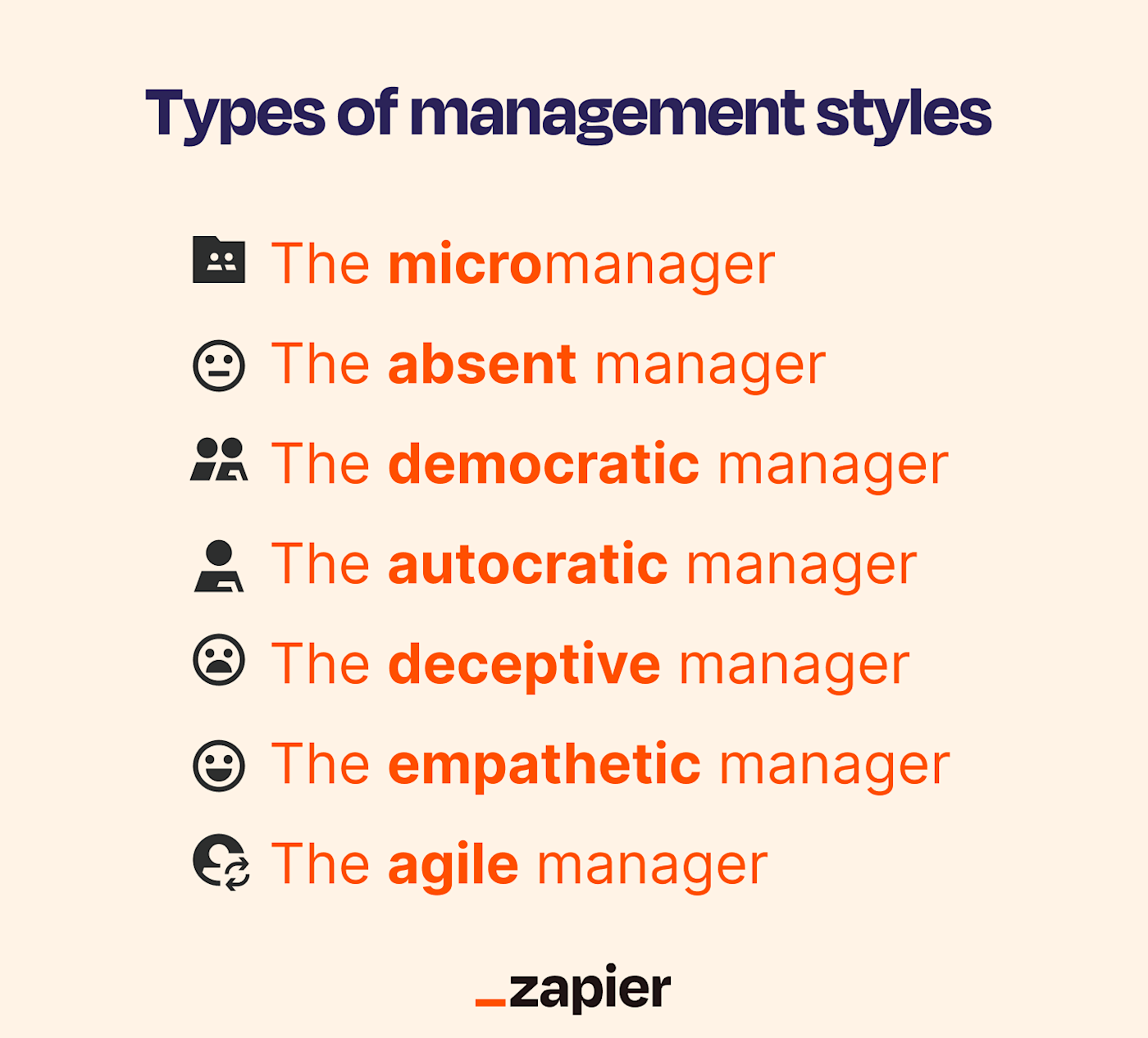You always remember your first bad boss. Thankfully, I’ve only worked with one manager whose leadership style was at odds with my working style. But let me tell you, I was happy to leave.
Alignment between managers and employees boosts morale and productivity—and reduces turnover. But a mismatch can tank a team.
Of course, there’s no one-size-fits-all management style. I asked both managers and employees about their experiences with different types of managers. Here’s what they shared.
What is a management style?
A management style influences how a manager leads and interacts with their team. Are they empathetic or detached? Hands-on or hands-off? Flexible or by-the-book? Management styles impact how managers:
Of course, managers are people with pre-existing personalities. Yes, they can change how they manage projects, but they also have to show up as themselves. Gauri Manglik, the CEO and co-founder of Instrumentl, shared:
“I think the biggest thing I’ve learned is that it’s important to be yourself. If you try to be something you’re not, your employees will feel it. But if you’re true to who you are as a manager, and if you stay honest about what you want from your employees, then everyone ends up better off.”
So while managers can absolutely adapt their leadership styles in management based on their company, their team, and their role, there are certain aspects of management style that are deeply personal. That’s important to remember when navigating manager-employee relationships.
7 types of management styles (and what you can learn from them)
Turns out humans are complex and dynamic, each with their own soft skills, so managers won’t always fit perfectly into prescribed management styles. Still, considering different management types can help us learn to work better together.

1. The micromanager
Micromanagement is always the first management style that comes to mind for me. Whether that’s because it’s a popular trope or because I still get flashbacks to having to log everything I did in a spreadsheet for one of my jobs as a college student and answer for any downtime may remain a mystery.
Krittin Kalra, the founder of Writecream, commented that “the micromanager is more focused on the task” than the person completing the task—or even the big picture it connects to. And as the world moved to remote work, micromanaging became even more tempting. But as Zapier CEO Wade Foster says, “Good managers don’t actually care what folks do with their time. They care if they get their job done or not.”
What managers can learn from this management style:
-
Start small with delegation. Micromanaging usually stems from a lack of trust. By delegating small projects (and then not micromanaging them), you can build trust and start to feel more comfortable taking a step back.
-
Focus on outcomes, not tasks. Unless there’s a problem with an employee’s output, added oversight usually does more harm than good.
-
Communicate the why when offering guidance. If you feel the need to micromanage because your team isn’t aligned, try giving big-picture feedback to see if that makes the smaller tasks fall into place.
How employees can work with this management style:
-
Steer the conversation toward impact, not tasks. If you’re able to bring proof of your work’s impact, your manager might be able to see that your methods are working and you don’t need such detailed oversight.
-
Ask the micromanager to outline their priorities. You can’t live up to their expectations if there’s uncertainty. With a list of their priorities, you can always refer back to it when asking them for space to do your work.
-
Keep track of any blockers. If something keeps you from meeting your manager’s expectations, like insufficient support, track and communicate that. If your manager is the blocker, it might be time to communicate that to your HR team.
Read more: Why employers should embrace quiet quitting
2. The absent manager
While micromanagers are too hands-on, the opposite approach isn’t much better. An absent manager leaves employees feeling abandoned or confused.
Andrei Vasilescu, the co-founder and CEO of Don’tPayFull, shared:
“While many people seem to always remember the micromanager, I also had one equally bad manager: the one who was completely checked out. At the time, it was hard to tell if it was a fear of confrontation, being unprepared for the role, or a combination of the two. Regardless, the team had no direction due to the lack of leadership, and that was one of the things that made me take a mental note. What you need in leadership is balance. Someone who leads and supervises but trusts the team enough to let them work independently.”
Absent managers can lead to employees feeling disconnected from the company and its goals, and they also run the risk of making employees feel undervalued.
What managers can learn from this management style:
-
Ask employees what they need to feel supported. It’s not always check-ins that people want—sometimes it’s just a general sense of direction. Each employee will thrive with a different level of support, and the best way to know is to ask.
-
Be honest about your knowledge. Managers shouldn’t be expected to know everything. If you aren’t sure of something, let employees know that you don’t know but are willing to look for an answer. And don’t let your impostor syndrome affect your direct reports’ experiences.
How employees can work with this management style:
-
Ask questions. Asking a lot of questions can indicate to your manager that you don’t have all the information or guidance you need. Just be sure you’re asking empathetically and focusing your questions on important topics.
-
Let your manager know what you need. Your manager may think they’re doing you a favor by being hands-off, especially if they’re trying hard not to micromanage. Start by letting them know that you need more support—they might be ready to offer it.
3. The democratic manager
Democratic managers treat their employees like their constituents—it’s the manager’s job to make decisions based on their direct reports’ input. Sully Tyler, an entrepreneur, noted how the democratic management style can work well:
“At work, I strive for a democratic management style. I really try to empower my employees to make decisions and have an impact on their own work environment. This way, you encourage the exchange of ideas and allow for feedback to be given openly so that problems can be identified and addressed early.
But I found it can be really ineffective if done wrong. In the beginning, it took a long time to decide after trying to hear everyone’s opinion, which ultimately hindered progress. I think that’s where the key to success and potential failure lies with this management style. You need to trust that your employees are there to help you progress with your company. But over time, you learn that the final decision is up to you, so you become better at sifting what’s useful.”
Employees want to be heard and have their opinions valued—and any successful company will trust its employees to have the company’s best interests at heart. But it’s up to managers to take all of the inputs and propose a strategic solution to any given problem. Remember, we’re talking democracy, not anarchy.
What managers can learn from this management style:
-
Always ask for employee input. Don’t make decisions in a silo before consulting with your team. At the very least, use your direct reports as a sounding board; but try to take it a step further and use their expertise to move the company forward.
-
Be decisive. Employees will look to you for answers, so you have to be ready to make tough decisions, sometimes even being a tiebreaker. Make sure you’re always able to communicate why you made the decision you did.
-
Create a problem-solving environment. When everyone’s ideas are on the table, feelings can get hurt. Focus on problem-solving, so the focus is on working together toward outcomes rather than taking credit for an idea.
How employees can work with this management style:
-
Know your strengths. By honing your strengths, you’ll be able to offer unique value. You want to be a well-rounded worker, but lean on your team to make up for gaps in your expertise.
-
Don’t take rejection personally. When everyone’s ideas are considered, yours will sometimes get outvoted or even just ignored. Remember, it’s not about you.
-
Return the trust. Your manager trusts you and your team enough to use your expertise and ideas to set and execute on strategy. Return the favor by trusting your manager when they have to make tough decisions.
4. The autocratic manager
Folks with an autocratic style of management take a “my way or the highway” approach. They don’t consult their team before making decisions, which might mean moving faster but never leads to the best results. Not to mention, as Vartika Kashyap, Chief Marketing Officer at ProofHub, told me, employees with autocratic managers can feel underappreciated and like cogs in a machine.
What managers can learn from this management style:
-
Make sure your employees feel appreciated. If employees don’t have any say in the strategic side of their work, they’ll feel undervalued and keep their eye on the door.
-
Explain why you make decisions. It’s ok to make decisions for your team, but always explain your reasoning to get everyone on board.
-
Listen to new perspectives. It’s no secret that two brains are better than one—and a teamful of brains is even better. Inviting others to share their ideas can offer a diversity of perspectives that will help you fill gaps in your knowledge or even just surface things you completely blanked on.
How employees can work with this management style:
-
Collaborate with your peers. If you’re able to approach your manager with ideas and suggestions from a group, it’s harder for them to ignore. Just be careful not to make it feel like you’re ganging up on them—that could have the opposite effect.
-
Ask why. If you can learn more about the decisions your autocratic manager is making, you’ll better understand how to frame your own ideas and suggestions in a way that aligns with their intentions.
5. The deceptive manager
A deceptive manager tells their employees one story but their boss another—and there’s no easier way to lose trust. Gates Little, CEO of altLINE Sobanco, calls this the “managerial Judas”:
“This is the manager who is kind, encouraging, and supportive to your face, then betrays you by blaming you in front of their boss or gaslighting you about promises they claim to have never made. This is the worst kind of manager because it chips away at your self-confidence and sense of professional expertise. It can also call your competence into question because it is your manager’s word against yours.”
The primary reason for a manager to be deceptive would be to protect or promote themselves, so it’s likely rooted in a personality trait that won’t change. If you experience this, it’s time to start figuring out how to remove yourself from the situation.
What managers can learn from this management style:
-
Be upfront. It can be tempting to tell two different stories in order to save someone’s feelings. But in the end, that will do more harm than good. If there’s an issue with an employee, tell them.
-
Be explicit. You likely have more context than your direct reports, so making broad-strokes statements can lead to miscommunication and crossed wires.
How employees can work with this management style:
-
Do your work in public. As much as possible, communicate with your manager in public channels (e.g., group calls, public Slack channels, group emails) so that everything is documented and it’s harder for them to change their tune in different contexts.
6. The empathetic manager
Empathetic managers focus on employees as much as (or more than) they focus on strategy and execution. That means being understanding when outside-of-work things affect inside-of-work things and encouraging direct reports to reach their full potential.
Paul Kushner, the CEO of My Bartender, noted that this can be particularly important in an industry that’s dominated by harsh or cold management:
“My experience managing a team in my own restaurant was shaped by the leaders who were encouraging, kind, and specific about expectations. Because they were so rare in my industry, I really listened when they spoke and absorbed their insights instead of just trying to survive service without being yelled at.”
Leaders with empathetic styles of management are also equitable—they’re not partial to one employee or another. For this reason, you’ll often see managers who are both empathetic and democratic.
What managers can learn from this management style:
-
Manage the human, not the worker. Address long-term negative patterns, while leaving wiggle room when life gets hard for employees.
-
Help employees see their potential. Build their confidence and guide them toward growth. And don’t forget to celebrate wins!
-
Reflect with your employees. Take time (with your direct reports) to assess what’s working and what’s not, within their role and their work.
How employees can work with this management style:
-
Don’t take advantage of empathy. Life gets in the way sometimes, but if you start to take advantage of your manager’s flexibility, it can lead to resentment.
-
Think about your own growth. Ask your manager how to grow your skills in areas you feel inexperienced in.
7. The agile manager
The agile manager is able to adapt to change. This means change in an industry, change in a company, and change in a team dynamic.
Robert Johnson, Marketing Director at Coast Appliances, explains:
“Agile management is a more targeted and flexible approach to evaluating the performance of team members and aligning project goals and next steps based on ongoing, changing metrics. The key qualities of an agile leader include tech savviness, open-mindedness, data-driven, and a good listener with a keen eye on rapidly changing employee, customer, and market demands.”
An agile manager doesn’t hold onto a single style or perspective if it no longer serves the team. As Jason Williams, the founder of Automate Life, put it, agile management means always being open to new ideas: “There is always room for improvement, and the best managers are open to learning from others, even if they aren’t in your direct line of command or management position,” he shared.
What managers can learn from this management style:
-
Protect your employees from change fatigue. While you need to be transparent with your team, it’s also good to prevent whiplash—before you share sweeping changes, make sure they’re set in stone and that you have the context you need to explain them.
-
Track progress. Focusing on data can help you be sure you’re flexible with your strategies and don’t stick to one route simply because it’s the path of least resistance.
-
Check your ego. Managers can have a lot of power, so check in with yourself often to be sure it’s not turning sour.
How employees can work with this management style:
-
Suggest improvements. Watch for trends and patterns, and flag them for your manager if you think there might be a better way of doing something.
-
Focus on high-impact tasks. Agile managers are looking for impact—not for specific tasks to get accomplished.
-
Be flexible. Things will change at work, and you need to be willing to roll with the punches. If you’re feeling overwhelmed with back-and-forth changes, let your manager know that it’s causing some whiplash.
What is your management style?
Your team, work, and perspective are constantly changing—and that means your management style (or your manager’s style) might change too. In fact, adapting your management style to each person on your team can be a huge strength.
In the end, there’s no best style of management. As an organization, you can set yourself up for success by hiring employees and joining companies that align with your company values. Here’s how James Taylor, the founder of James Taylor SEO, put it:
“Hiring managers that align with your team and people management strategies is the best method of ensuring that you don’t have a clash of ‘approach versus preference’ between management and employees later down the line.”
No two people are the perfect manager-and-employee match—but by being flexible and understanding the humans behind the roles, you can be sure that different types of management styles don’t break an organization.
Read more:
[adsanity_group align=’alignnone’ num_ads=1 num_columns=1 group_ids=’15192′]
Need Any Technology Assistance? Call Pursho @ 0731-6725516




